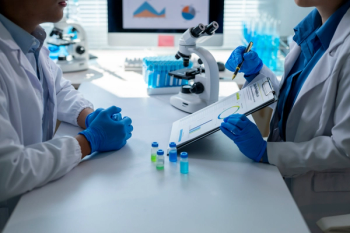
Making Algae Omega-3 Oil Work in Food and Beverage
Qualitas Health discusses pursuing GRAS affirmation for food and beverage use.
With a new dietary ingredient
Published in the
The company says that this is the first study examining the safety of an omega-3 oil from Nannochloropsis oculata, and Qualitas Health CEO Yuri Shosan said in a press release that the company is “moving steadily and deliberately toward GRAS status, which will open additional U.S. markets for functional foods and beverages.”
Achieving GRAS status “is still going to take us awhile, but this is one of the first steps,” added David Hart, Qualitas’s vice president of marketing, at Natural Products Expo West.
Can a concentrated marine ingredient like AlmegaPL work in food and drinks, given its organoleptic properties? (Read: “fishy” taste.) And what of concentrated algal oil’s dark green color that comes courtesy of its chlorophyll content? (Almega PL contains 3% chlorophyll, Hart said, breaking open an Almega PL capsule to show Nutritional Outlook editors the dark green oil-paste within.)
Only a few companies thus far have successfully incorporated algal oil in food and beverage. DSM’s Martek Biosciences Corp. (Parsippany, NJ) is one. Its DHA-rich life’sDHA algae strain has long been on the market in products ranging from bread and beverages to butter and yogurt. With its algal flour and protein, Solazyme (San Francisco, CA) is also using
Hart said Qualitas is looking at how to overcome algae’s organoleptic challenges for food and beverage, as it works towards GRAS affirmation. “There are a couple of ways of doing that,” he said. One is to use microencapsulation “to turn the oil into a powder,” he said, adding that “That’s something we’re working on looking into with different partners.” He called the initial results “promising.” Other options are to turn algal oil into an emulsion for liquid applications.
There’s yet another option. “One of the things that we’re looking towards in the future are slightly different forms of omega-3s from the algae. AlmegaPL has phospholipids and glycolipids and also chlorophyll, but if we use a different extraction technology, you get an EPA concentrate that is more similar to fish oil concentrates.” This, he said, “makes it a lot easier to formulate for food because the organoleptic impact, both in terms of color and also in terms of flavor, is less.”
Moving Ahead on Algae
Even as it pursues GRAS status, Qualitas already saw the first few
Qualitas is marketing AlmegaPL as an alternative to krill oil, citing the strain’s polar lipid structure, including glycolipids and phospholipids, as enhancing bioavailability. “It’s more similar to krill oil in the structure of the omega-3 fatty acids than it is to fish oil,” Hart said, noting that the glycolipids exclusive to Almega PL may even be “a better carrier for omega-3s than the phospholipids.”
Ingredients like krill and algae are inline with what omega-3 shoppers are looking for today, Hart added. “The market is moving towards high-value omega-3s, whether that’s krill oil or highly concentrated fish oils or algal oil. There’s this market shift towards higher value and bioavailability, and higher sustainability and/or vegetarian sources. We’re right in the middle of that, which is a nice place to be.”
Phototropically grown in open ponds, the ingredient-and algae in general-is a sustainable omega-3 source. Hart said that Qualitas is now purchasing sustainable energy credits for its operations, “so all of our electricity use now comes from renewable sources.”
Hart noted that the company’s regulatory and commercial successes have put the firm a step ahead in the growing algae market. “All of the people that have an omega-3 offering are also interested in algal-sourced omega-3s, so I think there will start to be a shift there as there are multiple choices of suppliers. Up until now, it was Martek, and now it’s Martek and us. I don’t know if any of the other algal startups will come to market this year, but you never know. The time to market, that road, is fairly long and complex,” including developing the right technology, commercial scale-up, as well as clinical and regulatory substantiation, he said. “That takes time.”
Editor-in-Chief
Nutritional Outlook magazine
jennifer.grebow@ubm.com
Photo © iStockphoto.com/Sasha Radosavljevic
Newsletter
From ingredient science to consumer trends, get the intel you need to stay competitive in the nutrition space—subscribe now to Nutritional Outlook.





